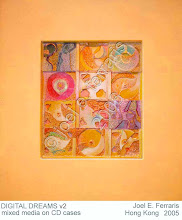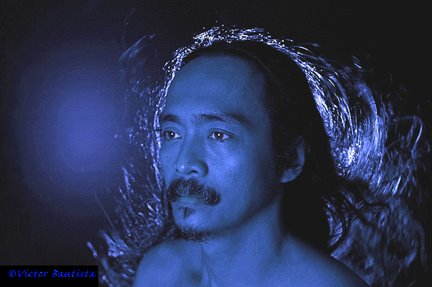
By Joel E. Ferraris
My original idea of modular but transformable artpieces started with the oil on canvas painting entitled NEOPHYTE. Deprived of a studio at that time to do large artworks and with shipping costs for large artpieces becoming a real headache, I started to think of ways to do art in large scale without the need for a very wide studio space.
As some art collectors, art galleries and auction houses are falling prey to con-artists selling fake art and where cheap art reproductions compete with or facilitate the demise of original works of art I felt the need to go on and continue aiming for and doing artpieces that are original.
To reach this goal I believe that as an artist I have to avoid too much reading and surfing the web for ideas and concepts that dictate schools of art and thought and to be firm from being swayed by widely accepted trends in the art world. To me ideas will come even if there are no influences from others. The method of oil painting on canvas, for example, are western but the ideas and themes to be painted on canvas could still be original.
With many different art materials readily available in huge supply in the market and where original ideas in artmaking seem to be dwindling, it is therefore a greener pasture for artists, old and young alike, to brave new horizons in search for new ways to present ideas that only they conceived of without the fear of being branded as belonging with or not the existing schools of art.
To illustrate my point, innocent children have the freedom to express and draw on paper images from their thoughts. They are like a glass full of clean and clear water whose thoughts and boldly spontaneous ideas do not belong with any box of influence. But adults, especially those that studied a lot of ideas and concepts, are like glasses full of soft drinks mixed with juices as they tend to be tainted with so much knowledge, influences and concepts copied or learned from others.
With the coming of the age of information technology where the availability of research materials are conveniently possible and where intellectual property is abused because of excessive commercialism, artists could become weak to the lure of strong influences and could sadly become copycats who are comfortable with styles that sell. When this thing happens, those that believe that art is dead will tend to believe that they are right while the rich art collectors could become poor buyers of art when they cannot differentiate a fake from an original.
Therefore, the glass has to be emptied to be able to allow the clear, clean water of ideas to pour in. But this is not easy especially if artists are tied to their fame and the good salability of their existing but monotonous style. Worst, they become brand names identified by the kind of style they have and an attempt to deviate from that comfortably salable style would mean a blow to one's income.
Art collectors, who collect art not because the artists are media-hyped while producing art without substance, will be luckier to add to their wall another piece that is genuinely original. On the other hand struggling artists, who are true to their art despite the odds, could someday establish links with serious art collectors who want to get their money's worth and that is where a new kind of friendship and mutual trust and respect could be started.
With the new innovation that I discovered in 1997, when deprivation turned to an advantage, my art collectors are happy and lucky to be able to collect several pieces of art for the price of one simply because these modular pieces could transform or mutate whenever it suits the owners preferences and space requirements for some certain periods of time.
NEOPHYTE, I WANT THEM FRESH, BUSY DAY BUSY NIGHT and PREGGY AND SEXY are the first four art pieces that fall in the category of this new innovation followed by PRY, BUZZ, SEE GAME that introduces a novel idea of using contemporary images and icons in the game of chess.
Lastly, to me artists must work with integrity because their art collectors have developed trust in them. A piece of art may rot one day despite efforts of restoration but an artist must work and strive to live a wholesome, clean life that would lead to the kingdom of the Supreme Creator who grants the artist his talent to see the beauty of things and thoughts from a mind created by Him.






















